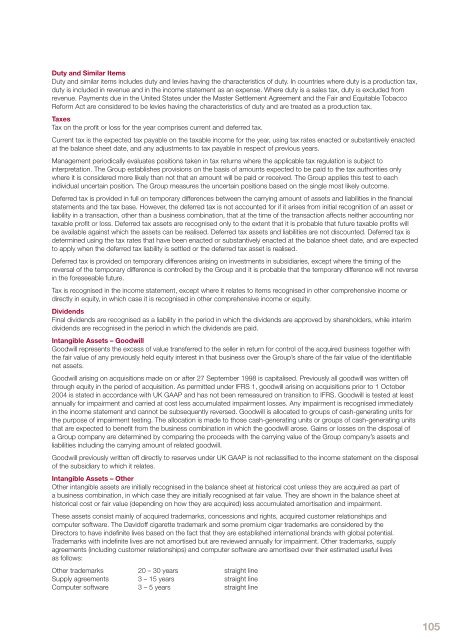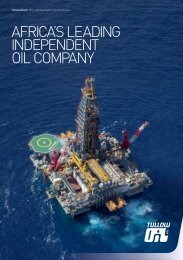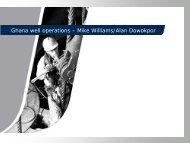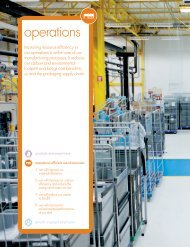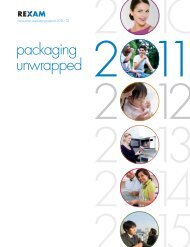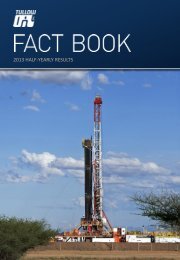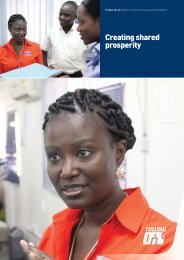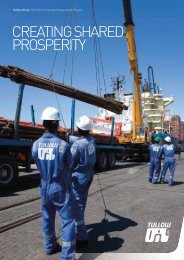Annual report 2010 - Imperial Tobacco Group
Annual report 2010 - Imperial Tobacco Group
Annual report 2010 - Imperial Tobacco Group
Create successful ePaper yourself
Turn your PDF publications into a flip-book with our unique Google optimized e-Paper software.
Duty and Similar ItemsDuty and similar items includes duty and levies having the characteristics of duty. In countries where duty is a production tax,duty is included in revenue and in the income statement as an expense. Where duty is a sales tax, duty is excluded fromrevenue. Payments due in the United States under the Master Settlement Agreement and the Fair and Equitable <strong>Tobacco</strong>Reform Act are considered to be levies having the characteristics of duty and are treated as a production tax.TaxesTax on the profit or loss for the year comprises current and deferred tax.Current tax is the expected tax payable on the taxable income for the year, using tax rates enacted or substantively enactedat the balance sheet date, and any adjustments to tax payable in respect of previous years.Management periodically evaluates positions taken in tax returns where the applicable tax regulation is subject tointerpretation. The <strong>Group</strong> establishes provisions on the basis of amounts expected to be paid to the tax authorities onlywhere it is considered more likely than not that an amount will be paid or received. The <strong>Group</strong> applies this test to eachindividual uncertain position. The <strong>Group</strong> measures the uncertain positions based on the single most likely outcome.Deferred tax is provided in full on temporary differences between the carrying amount of assets and liabilities in the financialstatements and the tax base. However, the deferred tax is not accounted for if it arises from initial recognition of an asset orliability in a transaction, other than a business combination, that at the time of the transaction affects neither accounting nortaxable profit or loss. Deferred tax assets are recognised only to the extent that it is probable that future taxable profits willbe available against which the assets can be realised. Deferred tax assets and liabilities are not discounted. Deferred tax isdetermined using the tax rates that have been enacted or substantively enacted at the balance sheet date, and are expectedto apply when the deferred tax liability is settled or the deferred tax asset is realised.Deferred tax is provided on temporary differences arising on investments in subsidiaries, except where the timing of thereversal of the temporary difference is controlled by the <strong>Group</strong> and it is probable that the temporary difference will not reversein the foreseeable future.Tax is recognised in the income statement, except where it relates to items recognised in other comprehensive income ordirectly in equity, in which case it is recognised in other comprehensive income or equity.DividendsFinal dividends are recognised as a liability in the period in which the dividends are approved by shareholders, while interimdividends are recognised in the period in which the dividends are paid.Intangible Assets – GoodwillGoodwill represents the excess of value transferred to the seller in return for control of the acquired business together withthe fair value of any previously held equity interest in that business over the <strong>Group</strong>’s share of the fair value of the identifiablenet assets.Goodwill arising on acquisitions made on or after 27 September 1998 is capitalised. Previously all goodwill was written offthrough equity in the period of acquisition. As permitted under IFRS 1, goodwill arising on acquisitions prior to 1 October2004 is stated in accordance with UK GAAP and has not been remeasured on transition to IFRS. Goodwill is tested at leastannually for impairment and carried at cost less accumulated impairment losses. Any impairment is recognised immediatelyin the income statement and cannot be subsequently reversed. Goodwill is allocated to groups of cash-generating units forthe purpose of impairment testing. The allocation is made to those cash-generating units or groups of cash-generating unitsthat are expected to benefit from the business combination in which the goodwill arose. Gains or losses on the disposal ofa <strong>Group</strong> company are determined by comparing the proceeds with the carrying value of the <strong>Group</strong> company’s assets andliabilities including the carrying amount of related goodwill.Goodwill previously written off directly to reserves under UK GAAP is not reclassified to the income statement on the disposalof the subsidiary to which it relates.Intangible Assets – OtherOther intangible assets are initially recognised in the balance sheet at historical cost unless they are acquired as part ofa business combination, in which case they are initially recognised at fair value. They are shown in the balance sheet athistorical cost or fair value (depending on how they are acquired) less accumulated amortisation and impairment.These assets consist mainly of acquired trademarks, concessions and rights, acquired customer relationships andcomputer software. The Davidoff cigarette trademark and some premium cigar trademarks are considered by theDirectors to have indefinite lives based on the fact that they are established international brands with global potential.Trademarks with indefinite lives are not amortised but are reviewed annually for impairment. Other trademarks, supplyagreements (including customer relationships) and computer software are amortised over their estimated useful livesas follows:Other trademarks 20 – 30 years straight lineSupply agreements 3 – 15 years straight lineComputer software 3 – 5 years straight line105


